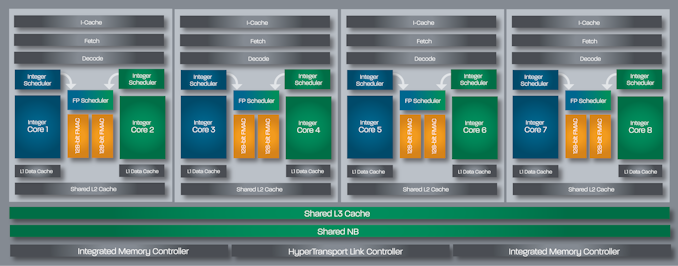AMD Bulldozer 'Core' Lawsuit: AMD Settles for $12.1m, Payouts for Some
by Anton Shilov on August 28, 2019 1:15 PM EST
AMD this month has agreed to pay compensation that totals $12.1 million to users who purchased FX-8000/9000 CPUs via its website or in the state of California. The case comes down to AMD advertising these processors as having 8 cores, and the claim that a shared FPU unit within a 'dual core' module does not constitute an actual core of performance similar to a separate core/FPU unit. Users who qualify for the compensation are estimated to recieve in the region on $35, depending on the exact uptake, and no one person can claim more than $7500.
AMD’s Bulldozer microarchitecture used 'dual-core modules' containing two independent ALUs and a shared FPU. AMD believed that such design allowed it to call its FX-8000 and FX-9000 series processors as the industry’s first eight-core desktop CPUs, yet the latter were quite often behind their quad-core rivals from Intel in terms of performance. As a result, a group of people from California filed a class action suit that accused AMD of false advertising back in 2015.
In early 2019, the Northern District Court of California sided with the plaintiffs and ruled that AMD’s FX-8120, FX-8150, FX-8320, FX-8350, FX-8370, FX-9370, and FX-9590 processors were incorrectly advertised as having eight cores. On August 23, the court published the class action settlement agreement under which AMD agreed to pay plaintiffs and the settlement class a compensation.
Under the terms of the deal, AMD has to create a $12.1 million settlement fund that will cover compensations to the end users, attorney fees, and settlement administration fees. The Class Counsel agreed to limit its petition for attorneys’ fees and reimbursement of expenses to no more than 30% of the fund, or $3.630 million, whereas the costs of settlement administration will be between $350,000 and $700,000. As a result, the pot to share between the actual purchasers of AMD’s select FX processors will be between $7.77 million and $8.12 million.
Purchasers entitled for up to $7500 total, have a confirmed purchase(s), and to have purched one of the processors while living in California or from AMD's website. It is noteworthy that people who bought AMD’s FX-8000E series CPUs with reduced power consumption are not eligible to get a reimbursement, and neither are people who purchased AMD’s six-core and quad-core FX-6000 and FX-4000 products.
It is hard to estimate how much money will each owner of AMD’s FX-8120, FX-8150, FX-8320, FX-8350, FX-8370, FX-9370, and FX-9590 processors will get, but considering the fact the settlement is limited to select CPUs and residents of California and those from AMD.com, actual sums may be quite sizeable. Should the actual value per unit be over $300, this will be subject to court approval.
AMD and the Settlement Administrator are order to crease a website at www.AMDCPUSettlement.com that should include the ability to file claim forms online. At press time, the website was offline, but it should be up shortly. We are awaiting AMD's official press release on the matter.
Update:
AMD has given an official comment on the result:
"AMD is pleased to have reached a settlement of this lawsuit. While we believe the allegations are without merit, we also believe that eliminating the distraction and settling the litigation is in our best interest."
Related Reading
- AMD's Steamroller Detailed: 3rd Generation Bulldozer Core
- The Bulldozer Review: AMD FX-8150 Tested
- The Bulldozer Aftermath: Delving Even Deeper
Sources: PACER, The Register (click through for document filing)











81 Comments
View All Comments
0ldman79 - Thursday, August 29, 2019 - link
This whole thing is a load of crap.The FPU is split anyway, it's just not a monster.
If the software was optimized for it, it would behave more like an 8 core. As nothing was optimized for it, it behaved like an 8 core with 4 FPU.
It's a baseless lawsuit and proves our government has no business making law regarding technology whatsoever.
nevcairiel - Friday, August 30, 2019 - link
The notion of a seperate FPU hasn't been reality since like a 486.Regardless, the far more important part is the shared frontend, which does instruction decoding. This is very often a bottleneck in modern processors, so sharing it over 2 cores does noone any favors.
It was basically one core with 2 integer pipelines. Not two cores with shared FPU and Frontend.
eek2121 - Thursday, August 29, 2019 - link
Yeah, I'm sorry, I get the need to settle a lawsuit, but this is not something I would have settled for.Xyler94 - Thursday, August 29, 2019 - link
Sometimes, it is cheaper to settle than to try and win.In this case, AMD just paid 12.1Mil, which if they had fought more with Lawyers, they potentially could have paid more. They made the decision to settle for a low amount, than to fight it in court.
In the end, laywers win
JoeyJoJo123 - Thursday, August 29, 2019 - link
Lawyers are the only ones that win in litigation.Operandi - Thursday, August 29, 2019 - link
AMD's expectation was certainly to have superior performance. Bulldozer was a big, complex, and ambitious architecture it was without a doubt aimed to take on Intel on the high-end of the market. If things would have worked out Bulldozer should have crushed Intel in general purpose work loads and pretty much anything that didn't heavily rely on complex floating point math. Of course thats not exactly what we got....silencer12 - Thursday, August 29, 2019 - link
Correction "You notice that Intel didn't call a Core i7 with Hyperthreading an "8 core" processor."Notice I fixed An for you instead of And
Manch - Friday, August 30, 2019 - link
Yeah the 386 and some 486 did not have an FPU, That was a physically different chip and extra $$. There are a lot of things included in cores now that were not included before. Now AMD has remove the memory controller back out. You want to bitch about how many cores are in Zen? Bulldozer was a poor design by virtue of noone building for it. Still those porcs are 8 cores. This lawsuit was bullshit but 12mil is probably the cheaper payout.RedGreenBlue - Wednesday, August 28, 2019 - link
Bulldozer cores do have identical cores. What? You want Intel to re-label their old chips when they double an FMAC pipe for a new architecture?eek2121 - Thursday, August 29, 2019 - link
No, not really. It blows that AMD let it get this far. However, the last CPU without an FPU was the 486 IIRC (sorry, a bit rusty in my old age). Anything Pentium and up had an FPU.